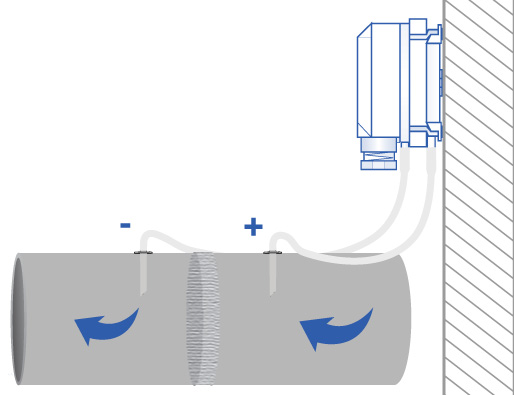EU declaration conformity
Differential pressure switch 20 - 200 Pa, including PVC tubes
Product description
Differential pressure relay to detect overpressure, vacuum or differential pressure. It can be used for air or other non-combustible, non-agressive gases.
The switching pressure setpoint can be adjusted by means of a scaled calibrated knob. This version detects differential pressure in the range of 20 to 200 Pa.
The output contacts can switch a resistive load of max 1 A / 250 VAC. Delivered with PSET-PVC-200, a set of flexible transparent PVC tubes (length 2 m).
Documents
Additional specifications and description
How does a differential pressure switch operate?
A differential pressure switch functions by detecting variations in pressure between two designated points. It comprises two ports connected to their respective pressure sources, allowing it to monitor the difference in pressure between them. When this difference surpasses a predetermined threshold, the internal diaphragm of the switch deflects, either establishing or interrupting a circuit connection. This change in the circuit triggers an alarm, alerting users to the pressure change. Users have the option to either pre-set the switching threshold or adjust it on-site.
A differential pressure switch functions by detecting variations in pressure between two designated points. It comprises two ports connected to their respective pressure sources, allowing it to monitor the difference in pressure between them. When this difference surpasses a predetermined threshold, the internal diaphragm of the switch deflects, either establishing or interrupting a circuit connection. This change in the circuit triggers an alarm, alerting users to the pressure change. Users have the option to either pre-set the switching threshold or adjust it on-site.

The series
The PSW series of differential pressure switches serve various purposes, such as enabling or disabling fans or pumps and monitoring the status of air filters in ventilation systems and air handling units. They find application in air handling units with heat exchangers to safeguard against freezing or to protect duct electrical heaters from overheating. These switches are designed to monitor overpressure, vacuum and differential pressure of air or other non-combustible, non-aggressive gases.
The PSW--200-PVC includes the PSW switch itself along with PSET-PVC connection nozzles and 2-meter long plastic tubes with mounting screws.
The PSW--200-PVC includes the PSW switch itself along with PSET-PVC connection nozzles and 2-meter long plastic tubes with mounting screws.
The PSET-PVC connects the differential pressure switch to the ductwork and allows for measuring differential pressure in Pascals. The nozzles are made from high-quality, heat-resistant gray r-ABS plastic, with a length of 83 mm and a diameter of 6.4 mm at the connecting end. The tubes are made of transparent PVC, with a diameter of 7 mm and a length of 2 m, with a maximum working pressure of 10.000 Pa and a maximum operating temperature of 60 °C.
The dry contact output of the differential pressure switch has a mean service life of 10.000.000 operations, with contact ratings of 1 A for resistive loads or 0,4 A for inductive loads (at 250 VAC).
The dry contact output of the differential pressure switch has a mean service life of 10.000.000 operations, with contact ratings of 1 A for resistive loads or 0,4 A for inductive loads (at 250 VAC).
Simplified installation
Installation is straightforward: simply mount the device on a suitable surface. Please bear in mind that the differential pressure switch must not be installed upside down with trip pressures of less than 50 Pa!
Connector P1 is designated for the higher pressure or lower vacuum, while connector P2 is for the lower pressure or higher vacuum. When the differential pressure increases, contact 3-2 closes, and contact 3-1 opens.
Installation is straightforward: simply mount the device on a suitable surface. Please bear in mind that the differential pressure switch must not be installed upside down with trip pressures of less than 50 Pa!
Connector P1 is designated for the higher pressure or lower vacuum, while connector P2 is for the lower pressure or higher vacuum. When the differential pressure increases, contact 3-2 closes, and contact 3-1 opens.
Protective housing
The switch is housed in a solid enclosure with a plastic cover, offering protection against dust, dirt, and water ingress. When combined with the plastic cover, the protection class is IP54.



Remarks, reviews & ratings